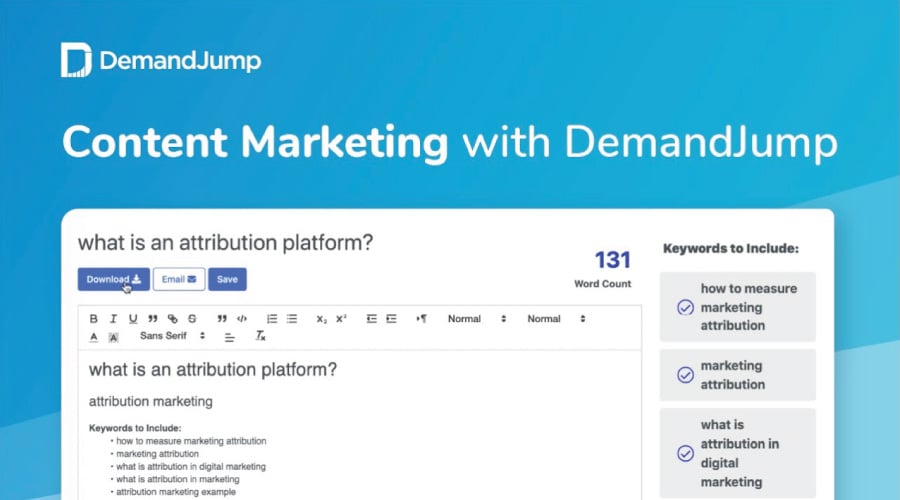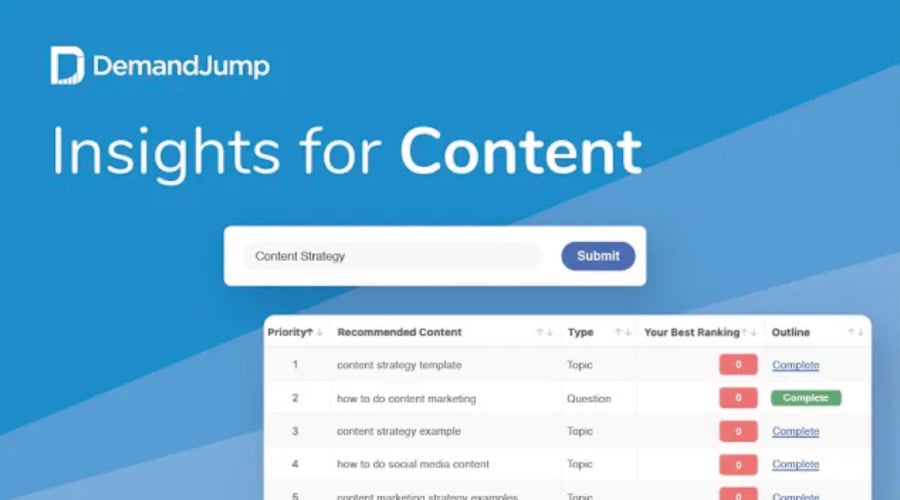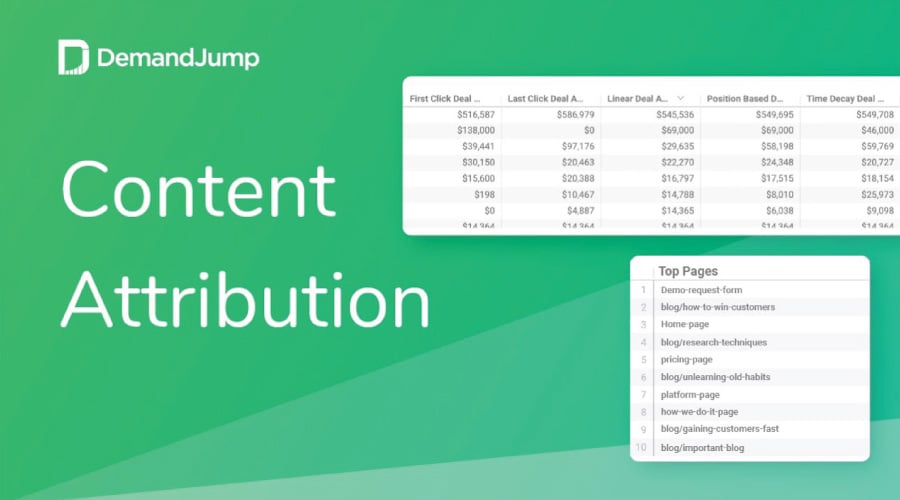What is SEO in digital marketing ? Search engine optimization, or SEO as it’s more famously called, refers to the ongoing process of optimizing a website and its contents to improve organic rankings on search engine results pages (SERPs). SEO has its roots in the late 1990s when Google, Ask.com, Yahoo, and MSN weren’t even household names yet. Since then, SEO strategy has become an increasingly integral part of digital marketing efforts, alongside other mainstays like social media marketing, paid ads, account-based marketing, and more.
Why is SEO so important? It all comes down to the way we, as humans, seek out information. We used to rely on dictionaries, encyclopedias, newspapers, and other forms of media, but the vast majority of people now turn to Google and other search engines for answers to their questions. In fact, while Google doesn’t publish data about the number of searches it processes, InternetLiveStats estimates that there are over 3.5 billion Google searches every single day.
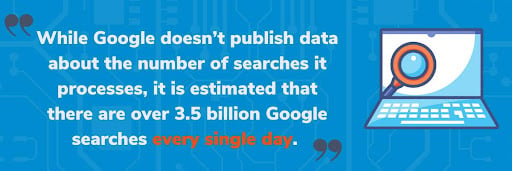
SEO improves your ability to get in front of even a small portion of these searchers. This increases not only your overall traffic, but also the potential for more leads, customers, and revenue! Of course, the caveat here is that it must be done well. Search Engine Journal reports that over 25% of searchers click on the first organic result on Google. The 10th result only gets about 2.5% of traffic, and the results past 10 are negligible at best.
In other words, if you’re not at the top of your SEO game, you’re probably missing out.
Fortunately, you’re not in it alone. Keep reading as we explore the different types of SEO, some of the greatest and latest SEO techniques you should implement, and even a short SEO tools list you can use to stock your toolbox.
What Are the 4 Types of SEO?
The four types of SEO in digital marketing include on-page, off-page, technical, and local SEO.
1. On-Page SEO
On-page SEO, sometimes called on-site SEO, refers to the process of optimizing or improving specific website elements for search engines. Content, images, title tags, meta descriptions, and keywords are all critical on-page SEO examples.
2. Off-Page SEO
Off-page SEO, on the other hand, refers to the practice of optimizing the elements that exist off of your website. This includes things like backlinks, social media posts, guest blogging, podcasts, earned media, and so much more.
3. Technical SEO
Technical SEO refers to the strategies of optimizing the backend or server side of a website to help search engines crawl and index your website more effectively. Technical SEO includes elements like mobile responsiveness, page load speed, and site architecture.
4. Local SEO
Local SEO refers to the process of optimizing a website so it’s more easily discoverable by people searching for local solutions. Local SEO is critical for businesses that operate within a specific region, and it includes things like targeting geo-specific keywords, maintaining a Google My Business profile, and soliciting reviews.
To make the most impact, your SEO strategy in digital marketing should take each of these types into consideration. While some may seem more important or relevant than others, the fact is that a well-rounded strategy helps ensure your site is optimized for search engines and people alike. But how do you do that? By using the right SEO techniques.
What Are SEO Techniques?
SEO techniques in digital marketing are tactics to optimize a website for on-page, off-page, technical, or local SEO. Ultimately, these techniques become part of your larger SEO strategy to rank higher on SERPs and generate more traffic—and ideally more customers and revenue, too! But what are the most common SEO techniques? Here are six must-have techniques for 2023 and beyond.
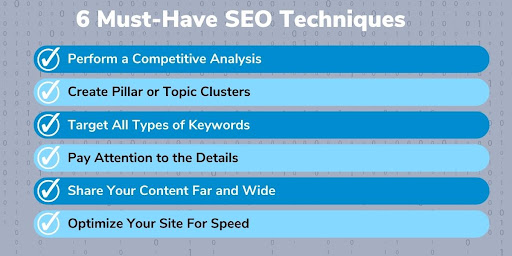
1. Perform a Competitive Analysis
Before building any sort of strategy, it’s important to understand how your competition is currently performing. Use this as your northstar as you develop a data-backed approach to taking over the organic market share in your industry. As you perform this analysis, keep an eye out for the following information:
- Who are your competitors, including big names and up-and-comers?
- What topics are your competitors ranking for?
- What specific keywords are they ranking for?
- What kind of content are they creating (blogs, long-form content, videos, etc.)?
- What topics or keywords are they missing?
- How does their website look, and how well does it perform?
2. Create Pillar or Topic Clusters
Looking to become an industry authority on a specific topic? One of the best ways to do this is by building a topic cluster around a specific topic. At DemandJump, we call these Pillars. We think this technique is so effective we developed an entire methodology around it: Pillar-Based Marketing! So what’s it look like? Your Pillar topic is a high-level topic that relates to your business. If you’re a SaaS marketing platform, you might choose “SaaS Marketing,” for example. From there, your cluster of content includes:
- Pillar: A 3,000 word article that covers the entire topic in broad strokes.
- Sub-Pillar: 2,000 word articles that take a slightly more targeted approach at a sub-topic.
- Supporting Blogs: 750 word articles that dive deep into a specific topic or question.
3. Target All Types of Keywords
Most marketers are familiar with short-tail and long-tail keywords. Short-tail keywords are short—think two to three words—while long-tail keywords are more than three words long and often include questions. The right SEO strategy should focus on capturing keywords from both these categories. But this isn’t the only way to categorize keywords. The best SEO techniques also take search intent into account as they select keywords:
- Informational keywords align with general research and the start of the customer journey.
- Commercial keywords illustrate that searchers are shopping around for options.
- Transactional keywords indicate that searchers are closing in on a purchase.
- Navigational keywords are further along in the journey where searchers seek you out by name.
As you’re researching and using keywords, be sure to avoid black or gray hat SEO techniques like keyword stuffing. These tactics are outdated, and are almost certain to cause your rankings to plummet.
4. Pay Attention to the Details
Not only do you need to analyze, plan, and craft excellent content, you also need to mind the details to give your site the best chance at moving up in the SERPs. As you consider which technical and on-page SEO techniques to use, ask yourself the following questions:
- Is your meta description catchy, and is it between the recommended 150-160 character limit?
- Are you tagging content effectively with H1s, H2s, H3s, and more?
- Are your images optimized, and did you include descriptive alt text for each one?
5. Share Your Content Far and Wide
While much of this list has focused on on-page SEO, one of the best off-page SEO techniques is simply getting the word out there. Doing so can help build brand awareness and drive more traffic to your site. What’s the best way to share your content? Consider the following:
- Create social media posts for new written, video, or audio content.
- Engage in guest blogging, especially with industry sites or publications.
- Develop a newsletter that promotes your newest and most relevant content.
6. Optimize Your Site For Speed
Since 2010, Google has clearly stated that page load speed matters for both desktop and mobile search results. Google also shares that the probability of a bounce increases about 32% as page load speed moves from one second to three. In other words, if your page load speed is longer than 3 seconds, you may see an uptick in your bounce rate. So how do you decrease load time? Here are a few options:
- Optimize and compress image sizes.
- Enable page and browser caching.
- Minify CSS, HTML, and JavaScript code.
- Disable or delete unused plugins.
Does that sound like a lot? It certainly can be, especially when you consider that SEO is often just part of your overall marketing strategy. Fortunately, there are a number of different SEO tools for digital marketing that can help you streamline and even automate some of these techniques.
What Are SEO Tools?
SEO tools are applications and platforms that help businesses with one or several aspects of search engine optimization. The fact is, there’s only so much time in the day, and these tools save time, remove guesswork, and let you focus on all the other aspects of your job. While there are a number of different tools on the market, here are six we think are worth checking out.

1 Ahrefs Backlink Checker
The Ahrefs Backlink Checker enables you to see how many backlinks you have, as well as other key data points about your site. You can use this tool to analyze you and your competitors’ performance. Simply enter a URL to find out information about the number of referring domains, the number of backlinks, and even an estimate of the organic traffic you’re getting from both referring domains and backlinks. This tool is available in both free and paid versions.
2. CWVIQ
CWVIQ is a handy, free tool that sends you an email when your page load speeds are slow. Simply enter your email address and domain, and CWVIQ will ping your website on a daily basis to check for slow load times.
3. DemandJump
DemandJump is the number one marketing strategy platform that is designed to drive page one rankings for the keywords that matter most to your target audience. With DemandJump, you can perform competitive analysis, build data-backed content strategies, perform keyword research, and generate one-click content briefs that illustrate what your customers want to know. And, you can track your rankings to see how your content performs over time.
4. Google Analytics
What are the tools used for SEO performance tracking? One is Google Analytics. Google Analytics is a free tool that shares valuable insights about your website performance. With Google Analytics, you can monitor up to 200 different metrics about site visitors, site visits, visitor behavior, acquisition efforts, conversions, and more.
5. Google Keyword Planner
There are several different free Google SEO tools out there, with Google Keyword Planner being one of the most common. While it’s designed to be used for building keyword lists for paid campaigns, Google Keyword Planner can be a great starting point for uncovering relevant keywords and trends.
6. Siteliner
Siteliner is a tool that’s designed to reveal site issues that could impact your SEO performance. Siteliner analyzes your website and highlights internal duplicate content and broken links, making it easy to resolve these issues quickly. You can use Siteliner to analyze sites with up to 250 pages for free, and there is a paid option to analyze larger sites.
DemandJump: Helping You Build to Page One
Search engine optimization is a lot. Not only do you have to keep track of so many different elements, but it can feel like the target is constantly changing. At DemandJump, we’re on a mission to make on-page SEO simple. Our platform aligns with the principles of Pillar-Based Marketing and provides a one-stop-shop for competitor research, strategy creation, and content writing. With DemandJump, you can build brand awareness, prove your authority, increase your page one rankings, and drive outcomes to new heights. Best yet—you can get started for free!






